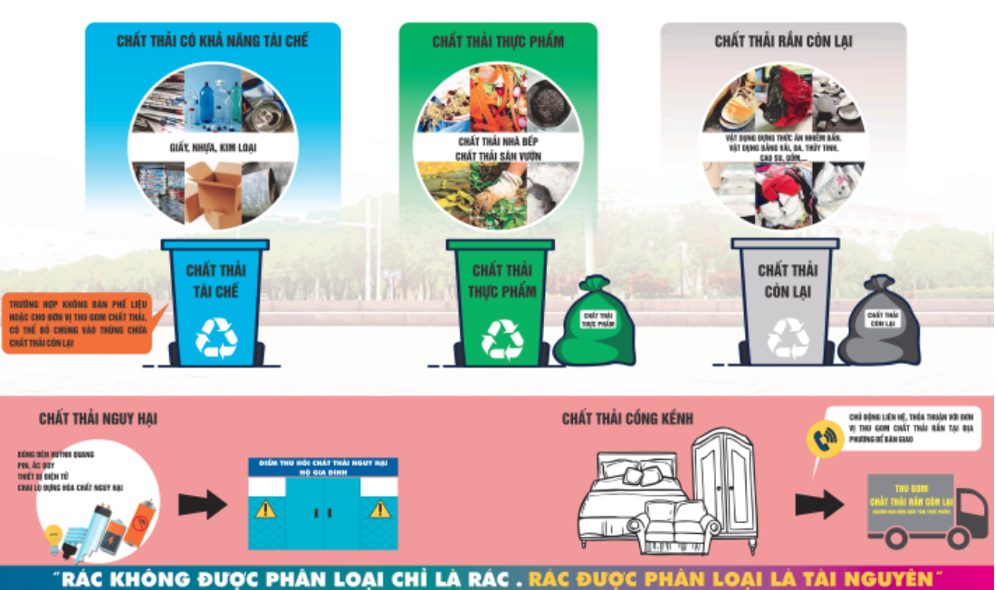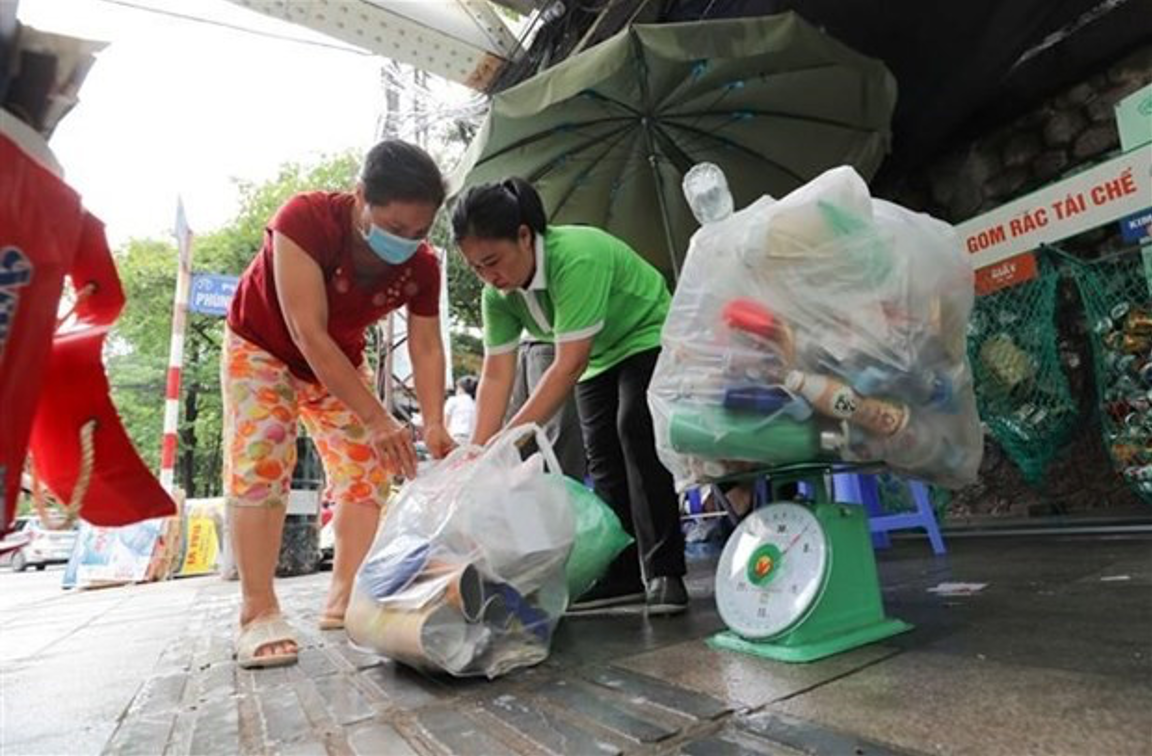

30/07/2024
In environmental protection work, separation at source of domestic solid waste at source is one of the urgent issues today. The Law on Environmental Protection No. 72/2020/QH14 (LEP) passed by the National Assembly on 17th November 2020, has 6 Articles stipulating the management of domestic solid waste, including the following contents: Separation at source, storage and transfer of domestic solid waste (Article 75); Aggregation points and transfer stations for domestic solid waste (Article 76); Collection and transport of domestic solid waste (Article 77); Treatment of domestic solid waste (Article 78); Costs of collection, transport and treatment of domestic solid waste (Article 79); Environmental remediation and improvement in domestic solid waste landfills (Article 80). These provisions guide how to manage and deal with waste; promote people to classify and minimize domestic solid waste generated at source, and at the same time, stipulate the responsibility of the Ministry of Natural Resources and Environment (MONRE), People's Committee at all levels, agencies, organizations, households and individuals in management of domestic solid waste.
Separation at source of domestic solid waste according to the local actual situation
One of the new points of the LEP 2020 is to change the approach to waste management with a consistent view of considering waste as a resource; promoting separation at source of waste at source; orienting how to manage and deal with waste, contributing to promoting circular economy in Viet Nam towards the goal of bringing a clean living environment for sustainable development. Implementing Clause 5, Article 79 of the LEP, on 2nd November 2023, the MONRE issued Technical Guidance on separation at source of domestic solid waste in Official Dispatch No.9368/BTNMT-KSONMT to support People's Committee of provinces and centrally run cities to study and apply in the process of developing and promulgating detailed regulations on separation at source of solid waste appropriate to the actual situation in each locality.
The Guidance is developed basing on the perspective of ensuring the compliance with the LEP 2020, Decree No.08/2022/NĐ-CP dated 10th January 2022 detailing a number of articles of the LEP, Circular No. 02/2022/ TT-BTNMT dated 10th January 2022 detailing the implementation of a number of articles of the LEP and other relevant legal documents, policies of the Party and State. The Technical Guidance provides maximum identification of all types of domestic solid waste generated during daily activities for local authorities to study and apply into regulations to ensure compatibility with local practice.
Clause 7, Article 75 of the LEP stipulates: The Vietnamese Fatherland Front Committee and socio-political organizations at all levels shall encourage residential communities, households and individuals to classify domestic solid waste at source; encourage rural households and individuals that generate domestic solid waste to classify, store and transfer domestic solid waste in accordance with regulations. Also, Clause 2, Article 79 of the LEP stipulates that in cases where households and individuals fail to classify or classify not as prescribed in Points a and b, Clause 1, Article 75 of the LEP, they must pay charges for collection, transport and treatment services as other types of domestic solid waste. With these provisions in the LEP mentioned above, households, individuals can choose between classifying domestic solid waste according to regulations or paying charges for collection, transport and treatment of domestic solid waste in case of non-separation at source or improper separation at source. At the same time, the LEP has shown the spirit of encouraging, not requiring, the implementation of separation at source of domestic solid waste through assigning responsibility to the Vietnamese Fatherland Front Committee and socio-political organizations at different levels to mobilize communities, households, and individuals to classify domestic solid waste. Besides, the implementation of the separation at source of domestic solid waste depends on natural, socio-economic conditions, infrastructure for collection, transport and treatment, specific treatment technology applied in each locality in practice.
International experience shows that there are no general regulations applicable across the entire country, but each state or each region has different separation at source methods to ensure the effectiveness of waste recycling and treatment. Therefore, the MONRE has developed the Technical Guidance on separation at source of domestic solid waste in the form of an official dispatch as a basis for the Provincial People's Committee to study and apply in the process of developing and promulgating detail regulations to ensure feasibility in each locality.
Separation at source of waste to optimize waste resources
Separation at source of domestic solid waste aims to separate waste worth recycling at source, contributing to creating a source of raw materials for recycling activities and reducing the volume of domestic solid waste landfilled. Accordingly, the Technical Guidance on separation at source of domestic solid waste provides maximum identification of the types of domestic solid waste generated from households and individuals, classifying waste into 3 main waste groups in accordance with Clause 1, Article 75 of the LEP such as: (1) Reusable and recyclable solid waste is divided into 8 subgroups including waste paper; waste plastic; waste metal; waste glass; fabric, leather goods; wooden goods; rubber; discarded electrical and electronic equipment. (2) Food waste; (3) Other domestic solid waste is divided into 3 subgroups including hazardous waste; bulky waste; other waste.
For reusable and recyclable solid waste such as waste paper, waste plastic, waste metal, waste glass... it is necessary to remove water and solution contained inside, food, original container; compact, flatten, reduce size and volume; collect and stack sharp objects to avoid injury during separation at source, collection and treatment. For waste that is fabric, leather, and wood, clean objects and intact objects should be reused; compact, reduce size and volume of damaged items for recycling. For discarded electrical and electronic equipment such as cameras and video recorders; mobile phones and landline phones; desktop computers and monitors; refrigerators, freezers, air conditioners... need to keep their shape and do not disassemble.
For food waste such as leftovers; expired food; vegetables, tubers, berries, fruits and waste parts after preparing and cooking food, etc.; discarded products from livestock and poultry meat; seafood, those must be guaranteed to be stored in sealed containers, bags, packaging, etc., without leaks, preventing odours from spreading.
For other domestic solid waste that is divided into 3 subgroups:

Hazardous waste subgroup is packaging containing pesticides, waste acids, waste solvents, waste alkalis... from daily activities; paints, inks, adhesives (types with hazardous ingredients in production raw materials); gloves, rags stained with oil and chemicals; contaminated needles, masks, and bandages from patients must be stored in containers, bags, packaging, etc for safety and to avoid dispersing hazardous waste into the environment; collect and stack sharp objects (such as needles) to avoid injury during separation at source, collection and treatment. For waste as waste fluorescent light bulbs; waste activated glass; thermometer containing waste mercury, do not break them. In case of breakage, store them safely to avoid injury and prevent the spread of mercury during separation at source, collection and treatment. For waste batteries and accumulators, must keep their shape and do not disassemble.

Separation at source of domestic solid waste in Da Nang
Bulky waste subgroup such as old and broken cabinets, tables and chairs, sofas, beds, mattresses; iron cabinets, door frames, doors... they need to be compacted, reduced in size and volume. In case of dismantling, the waste is then classified into corresponding waste groups.
Other remaining waste subgroup is nut shells, egg shells, coconut fiber, straw, rice husks... from daily activities; sedge mats; bamboo mats; rattan, bamboo pillows...; cattle and poultry hair...; coffee grounds, tea (tea bags), sugarcane bagasse, sugarcane residue, corn cob...; gardening waste from households such as leaves, roots, small branches, grass, flowers... they need to be compacted, reduced in size and volume. For pet feces; carcasses of pet animals that die not due to disease... they need to be stored in a sealed, leak-proof container to prevent the spread of odours. For waste as used diapers, bandages, toilet paper, and tissue paper; all kinds of foam boxes; single-use plastic products; gum residue, cigarette filters...; balloons, tape, earring picks, toothpicks; medicine shells... they need to be compacted, reduced in size and volume, ensuring to avoid spillage.
To implement regulations on separation at source of domestic solid waste, the MONRE is responsible for stipulating technical requirements on environmental protection for aggregation points and transfer stations of domestic solid waste in Clause 2, Article 76; stipulating technical requirements on environmental protection for vehicles transporting domestic solid waste; promulgating criteria on domestic solid waste treatment technology; developing guidance on pricing methods for domestic solid waste treatment services; stipulating economic and technical norms on collection, transport and treatment of domestic solid waste; guiding the technical separation at source of domestic solid waste; guiding the implementation of provisions (Clause 1 and 5, Article 79); guiding for closing landfill sites for domestic solid waste (Clause 4, Article 80).
People's Committee of provinces and centrally run cities are responsible for deciding on the specific separation at source of other domestic solid waste according to the Guidance of the MONRE (Clause 2, Article 75); arranging premises for aggregation points and transfer stations for domestic solid waste to meet environmental protection requirements according to regulations of the MONRE (Clause 2, Article 76); selecting establishments to collect and transport domestic solid waste (Clause 1, Article 77); selecting establishments to treat domestic solid waste (Clause 2, Article 78); planning and allocating land fund for domestic solid waste treatment area, implementing timely land allocation to deploy construction and operation of domestic solid waste treatment area in the local area; allocating funds for investment in construction and operation of collection, storage, transfer, transport and treatment systems of domestic solid waste, systems of public works, measures and equipment serving the management of domestic solid waste in the area (Clause 6, Article 78); stipulating in detail the management of domestic solid waste of households and individuals in the area; stipulating specific prices for services of collection, transport and treatment of domestic solid waste; stipulating the specific form and level of funding that households and individuals must pay for the collection, transport and treatment of domestic solid waste based on the mass or volume of classified waste (Clause 6, Article 79).
People's Committee of provinces and centrally run cities shall study and apply the Technical Guidance on separation at source of domestic solid waste to develop plans and implement separation at source activities of domestic solid waste generated from households, individuals in the area, ensuring compliance with provisions of the LEP and guiding documents for implementation which note the separation at source of domestic solid waste to promote increased reuse and recycling of waste and discarded products, maximize the value, and extend the life cycle of products and materials; encourage agencies, organizations, communities, households and individuals to participate in recycling and treatment programs for waste produced and imported by organizations and individuals in accordance with provisions of the LEP and other documents guiding the implementation; minimize the amount of waste that must be treated. The separation at source of domestic solid waste needs to be consistent with the existing environmental protection technical infrastructure and waste treatment technology, natural, economic and social conditions; consistent with waste management content in provincial master plans and national environmental protection master plans, local financial resources.
In addition, People's Committee of provinces and centrally run cities organize propaganda and dissemination for agencies, organizations, communities, households, and individuals to classify domestic solid waste from households and individuals; implement the separation at source of domestic solid waste no later than 31st December 2024.
Nguyễn Hằng
(Source: The article was published on the Environment Magazine by English No. II/2024)